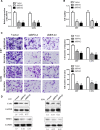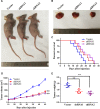Linc00475 promotes the progression of glioma by regulating the miR-141-3p/YAP1 axis
- PMID: 33336871
- PMCID: PMC7810941
- DOI: 10.1111/jcmm.16100
Linc00475 promotes the progression of glioma by regulating the miR-141-3p/YAP1 axis
Abstract
Glioma is the most prevalent and lethal primary brain tumour. Abundant long non-coding RNAs ( lncRNAs) are aberrant and play crucial roles in the oncogenesis of glioma. The exact functions of linc00475 in glioma remain blurred. Here, we analysed the expression levels of linc00475 by qRT-PCR and discovered that linc00475 was up-regulated in glioma and predicted a poor prognosis in patients with glioma. Besides, inhibiting linc00475 restrained the progression of glioma in vitro and in vivo. Further experiments confirmed that linc00475 regulated the progression of glioma by acting as a sponge for miR-141-3p. Moreover, we detected the binding sites of linc00475 and miR-141-3p, the YAP1- 3'UTR and miR-141-3p by luciferase reporters. The rescue assays confirmed that inhibiting linc00475 restrained the progression of glioma through the miR-141-3p/YAP1 pathway. Collectively, our research demonstrates the key roles of linc00475 in glioma, which could be a promising therapeutic target.
Keywords: YAP1; ceRNA; glioma; linc00475; miR-141-3p; prognosis.
© 2020 The Authors. Journal of Cellular and Molecular Medicine published by Foundation for Cellular and Molecular Medicine and John Wiley & Sons Ltd.
Conflict of interest statement
The authors declare that they have no competing interests.
Figures






Similar articles
-
LncRNA NNT-AS1 promotes non-small cell lung cancer progression through regulating miR-22-3p/YAP1 axis.Thorac Cancer. 2020 Mar;11(3):549-560. doi: 10.1111/1759-7714.13280. Epub 2020 Jan 10. Thorac Cancer. 2020. PMID: 31923353 Free PMC article.
-
Long non-coding RNA LINC00346 regulates proliferation and apoptosis by targeting miR-128-3p/SZRD1 axis in glioma.Eur Rev Med Pharmacol Sci. 2020 Sep;24(18):9581-9590. doi: 10.26355/eurrev_202009_23046. Eur Rev Med Pharmacol Sci. 2020. PMID: 33015801
-
Long non-coding RNA PICSAR knockdown inhibits the progression of cutaneous squamous cell carcinoma by regulating miR-125b/YAP1 axis.Life Sci. 2021 Jun 1;274:118303. doi: 10.1016/j.lfs.2020.118303. Epub 2020 Aug 22. Life Sci. 2021. PMID: 32841663
-
Long noncoding RNA APTR contributes to osteosarcoma progression through repression of miR-132-3p and upregulation of yes-associated protein 1.J Cell Physiol. 2019 Jun;234(6):8998-9007. doi: 10.1002/jcp.27572. Epub 2018 Oct 14. J Cell Physiol. 2019. PMID: 30317613
-
Effects of microRNAs and long non-coding RNAs on chemotherapy response in glioma.Epigenomics. 2022 May;14(9):549-563. doi: 10.2217/epi-2021-0439. Epub 2022 Apr 27. Epigenomics. 2022. PMID: 35473299 Review.
Cited by
-
Metastatic EMT Phenotype Is Governed by MicroRNA-200-Mediated Competing Endogenous RNA Networks.Cells. 2021 Dec 28;11(1):73. doi: 10.3390/cells11010073. Cells. 2021. PMID: 35011635 Free PMC article. Review.
-
The interplay between noncoding RNA and YAP/TAZ signaling in cancers: molecular functions and mechanisms.J Exp Clin Cancer Res. 2022 Jun 14;41(1):202. doi: 10.1186/s13046-022-02403-4. J Exp Clin Cancer Res. 2022. PMID: 35701841 Free PMC article. Review.
-
Development of a novel angiogenesis-related lncRNA signature to predict the prognosis and immunotherapy of glioblastoma multiforme.Transl Cancer Res. 2023 Jan 30;12(1):13-30. doi: 10.21037/tcr-22-1592. Epub 2022 Dec 22. Transl Cancer Res. 2023. PMID: 36760384 Free PMC article.
-
Human umbilical cord mesenchymal stem cell-derived exosomes carrying hsa-miRNA-128-3p suppress pancreatic ductal cell carcinoma by inhibiting Galectin-3.Clin Transl Oncol. 2022 Mar;24(3):517-531. doi: 10.1007/s12094-021-02705-7. Epub 2021 Nov 23. Clin Transl Oncol. 2022. PMID: 34811696
-
Silencing of lncRNA CHRM3-AS2 Expression Exerts Anti-Tumour Effects Against Glioma via Targeting microRNA-370-5p/KLF4.Front Oncol. 2022 Mar 11;12:856381. doi: 10.3389/fonc.2022.856381. eCollection 2022. Front Oncol. 2022. PMID: 35359381 Free PMC article.
References
-
- Liu B, Cao W, Ma H. Knockdown of lncRNA LSINCT5 suppresses growth and metastasis of human glioma cells via up‐regulating miR‐451. Artif Cells Nanomed Biotechnol. 2019;47:2507‐2515. - PubMed
Publication types
MeSH terms
Substances
Grants and funding
LinkOut - more resources
Full Text Sources

